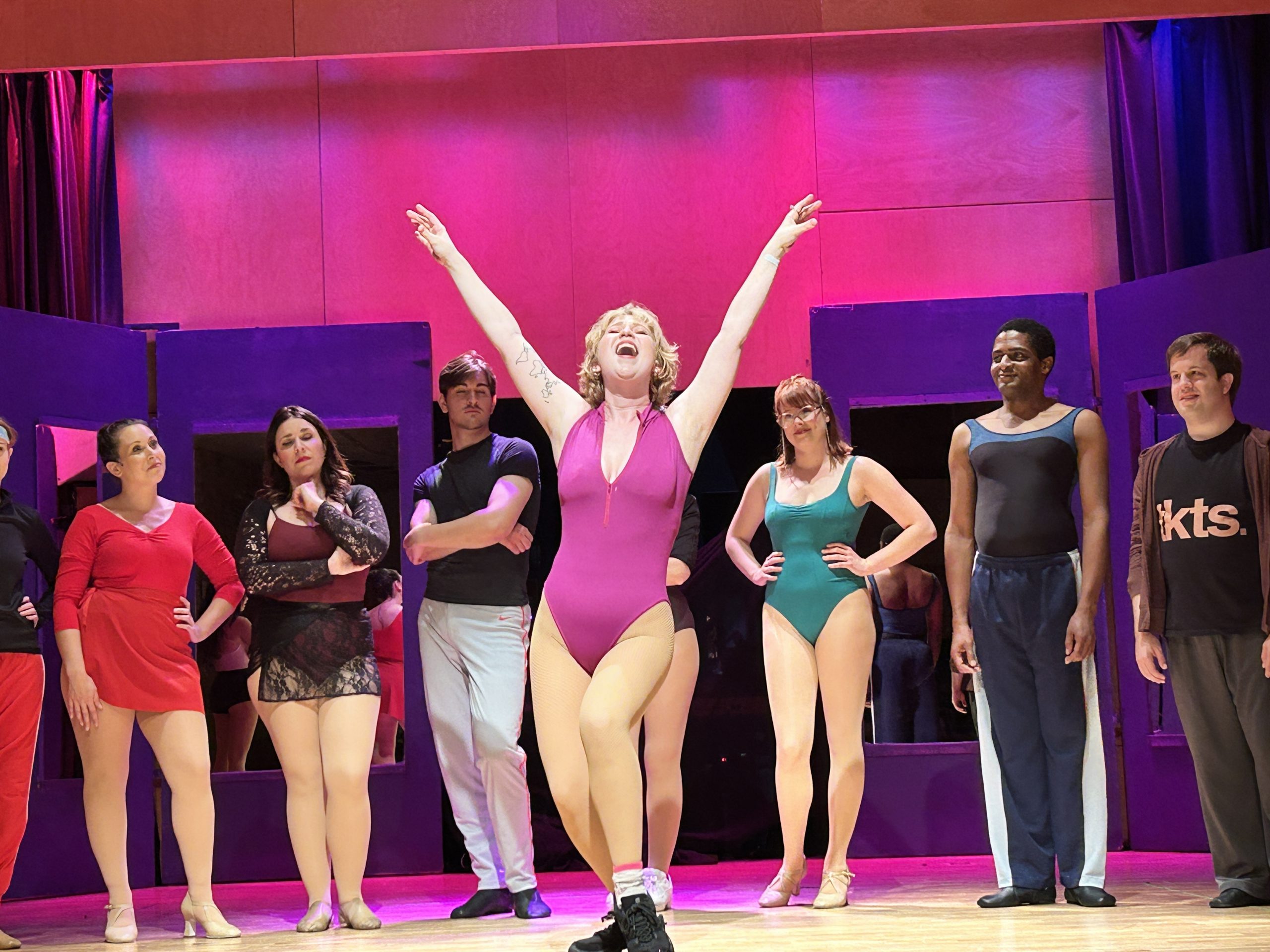A Chorus Line had its Broadway premiere in 1975. It won nine Tony Awards including Best Musical, Best Book, and Best Original Score.
Featuring music by Marvin Hamlisch, lyrics by Edward Kleban, and book by James Kirkwood Jr. and Nicholas Dante, A Chorus Line is a testament to the struggles of performers to stay working (or in some cases start working) in the entertainment industry.
Specifically, A Chors Line dramatizes the audition process for a Broadway show. In particular, this lively yet touching musical details the events that can go on at a Broadway dance audition.

I’ve been through Broadway dance auditions. While I wouldn’t say my dance abilities ever outshined my singing and acting skills, I was good enough to work steadily as a professional. I also taught dance on the college level. Even with that resume, I wouldn’t put my ranking in the top 70% of the room at those auditions.
I can tell you from that first-hand experience that the level of talent needed to even get a second glance at a Broadway dance call is pretty monumental. You need to learn the routines and execute them flawlessly – all in a matter of a very short time. There simply isn’t room for people who aren’t on an expert skill level.
Typically, the success of any local or regional mounting of A Chorus Line requires a cast of performers who can believably pull off dance routines suggestive of what a real Broadway dancer can do. In this kind of traditional casting, everyone in the cast must excel in ballet, tap, jazz, and modern.
That is the traditional approach to A Chorus Line. But there is no law that says you have to follow the exact same recipe for every production.

MadKap Productions, the resident company providing top-quality entertainment at the historic Skokie Theatre, has demonstrated over time that they aren’t afraid to try creatively different interpretations of some works. That is exactly what producer Wendy Kaplan and director Wayne Mell have done with their production of A Chorus Line running through October 8th in Skokie – part of Chicago’s vibrant North Shore arts scene.
Admittedly, A Chorus Line can be a tough show to cast. The way the production is scripted, it calls for 17 triple-threat performers who can delight audiences with equal mastery of singing, acting, and dancing.
As a director, you have to make the best use of the talent you have available. And, that can sometimes mean changing your interpretation of the show in order to match the pieces you have at your disposal.
Skokie Theatre’s A Chorus Line doesn’t feature a lot of performers who would list dance as their primary talent. Instead, the focus of the show becomes about the dream of being a performer and the risks we take in exposing ourselves to judgment in order to try to make It happen.
Thus, with this adjusted focus, the show becomes very much about a group of Chicago talents of various backgrounds and points in their career taking full advantage of a chance to play roles that they might not otherwise have the opportunity to tackle. Because, the characters in A Chorus Line are all extremely desirable ones to portray.
The principal characters in the play include 17 dancers in the final callback for a Broadway show being helmed by an established director and choreographer with a reputation for demanding perfection from his talent.

The context of A Chorus Line is that the director, Zach, is looking for the right personalities to fill four male and four female ensemble parts. To make it to this point in a real Broadway audition you would have already proven to have the song and dance skills for the show. That shouldn’t even be a question.
As Zach points out, at this juncture it’s about who is the right fit to work with each other day in and day out. To do that, he engages in an interview process with the prospectives in which he is part investigator and part armchair psychologist. The interview technique invoked by Sean M. G. Caron in his interpretation of the character makes the director at times a protagonist and at other times more of an antagonist.
This complexity of character is not reserved for Zach alone. Each of the dancers on stage competing for those choice spots gets to reveal the deep secrets, funny reflections, and hopeful dreams that make them subject themselves to such fickle judgment. That’s part of the appeal for actors wanting to take on these beautifully written characters. They all have amazing character arcs to explore.
The MadKap Productions version of A Chorus Line at Skokie Theatre features some excellent actors. Not to take anything away from any of the other performers; Erin Renee Baumrucker as Shelia, Lili Javorka as Val, Madison Jaffe-Richter as Kristine, Whitney Marie Wolf as Judy, and Maddy Shilts as Bobby shine exceptionally bright in their moments talking in the spotlight.
A number of the performers also have fantastic vocal skills. Most delightful are the numbers where the performers shine both in the singing and acting of the song.
At the Ballet is a powerful number featuring the talents of Baumrucker’s Sheila, Rae Robeson’s Bebe, and Wolf’s Judy. Sadly, it is not uncommon for performers to gravitate towards the arts because it provides a way to escape from childhood trauma or parental neglect by pretending to be someone else for a while. This touching song provides insight into the kind of childhood that might inspire such a desire to escape.

Javorka’s Val is a seasoned dancer who had all the talent in the world but didn’t start getting cast until she added breast enlargement surgery and a nose job to her resume. It’s a funny number that Javorka sells to the fullest. It also has an underlining ribbon of sadness that some feel compelled to change so drastically just to get cast in a show. If it’s to make yourself feel better it’s one thing, if it’s to please someone else it’s a different level of sacrifice.
But that’s the underlying theme of A Chorus Line. How far would you go to be a working dancer? Are you willing to study countless hours? Are you willing to move to a strange city away from everyone you know? Are you willing to perform in drag? Are you willing to undergo surgery – whether that be to change your appearance or squeeze a little more life out of a damaged knee? Where do the compromises end?
There is one really great dance number in the show. This show was written in the 1970s and at the time it was very rare for little boys to pursue dance lessons. I Can Do That is a playful number in which the exceptionally talented tap dancer Mike explains how he got started taking dance class as a child – taking over the lesson his parents paid for that his sister didn’t want to go to anymore.
Tyler Meyer, who plays Mike in the Skokie production, has dance skills that absolutely sizzle. And the young man has a phenomenal voice and an exciting way of selling a song. Although he is arguably the best dancer in the cast in many dance disciplines, he isn’t a tap dancer. While it is ironic to have a song about tap dancing not feature tap dancing, thanks to the creativity of choreographer Susan Pritzker, Meyer’s solo number is the dance highlight of the show.
Pritzker can be commended for her work overall. Choreographing a show about great dancers without the traditional kind of cast is a challenge that Pritzker handles with excellence. There are a few numbers that might be better served to be trimmed, but without that option on the table what she has created is really impressive.

I applaud all the performers in A Chorus Line for sharing their skills in such a meaningful show. There is one absolute gem in the cast that sparkles with the shine of a princess-cut diamond. Madison Jaffe-Richter is a bonafide triple threat that could be plucked out and put in the cast of a regional-level theater. With a few tap classes and a good acting coach, Meyer could be to that talent level in short order too.
The other members of the line include Elizabeth Bushell as Vicki, Luis Del Valle as Paul, Emma Drazkowski as Maggie, Marcela Ossa Gómez, Trevor Hendrix as Greg, Ben Isabel as Al, Khnemu Menu-Ra as Richie, Madelynn Öztaş as Connie, Chandler Paskett as Don, Sarah Sapperstein as Cassie, and Jason Sekili as Mark. Each makes their role uniquely their own.
The music direction for the production is by Jeremy Ramey, who also serves as conductor and keyboardist. I am a fan of Ramey’s work. It is consistently excellent. Joining Ramey in the small but capable orchestra is Maddi Vogel on drums, Michael Bulaw on bass, and Nate Hall on guitar and saxophone.
Ben Paynic serves as dance captain and in the onstage role of Larry – Zach’s assistant choreographer. Mell is aided by assistant director Miranda Cole and stage manager Ayla Sweet. Costumes are by Patti Halajian, lighting design is by Pat Henderson, and sound design is by Chris Cook.

There are all different levels of theater. The way I approach theater reviews is to acknowledge how well a creative team does under their own unique circumstances.
I once was hired to direct a production of Grease and had to make it work with an all-female cast. But you know what? I did make it work. That’s what directors do.
The production of A Chorus Line waiting for you at Skokie Theatre is a far different approach than I have seen done before. Director Wayne Mell, choreographer Susan Pritzker, and music director Jeremy Ramey have taken an eager group of performers and present them in a way that best showcases their talents and gives them each an opportunity to bask in the spotlight.
That’s the dream of every character in A Chorus Line – to be given the chance to shine.
A Chorus Line plays Fridays and Saturdays at 7:30 PM and Sundays at 2 PM through October 8, 2023. The Skokie Theatre is located at 7924 Lincoln Avenue in Downtown Skokie. For ticket information visit www.SkokieTheatre.org or call (847) 677-7761.
Photo credit: MadKap Productions
For more reviews visit: Theatre in Chicago – your source for What’s on Stage in the Chicago Area




